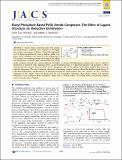Biaryl Phosphine Based Pd(II) Amido Complexes: The Effect of Ligand Structure on Reductive Elimination
Author(s)
Arrechea, Pedro L; Buchwald, Stephen Leffler
Downloadjacs.6b05990.pdf (1.628Mb)
PUBLISHER_POLICY
Publisher Policy
Article is made available in accordance with the publisher's policy and may be subject to US copyright law. Please refer to the publisher's site for terms of use.
Terms of use
Metadata
Show full item recordAbstract
Kinetic studies conducted under both catalytic and stoichiometric conditions were employed to investigate the reductive elimination of RuPhos (2-dicyclohexylphosphino-2′,6′-diisopropoxybiphenyl) based palladium amido complexes. These complexes were found to be the resting state in Pd-catalyzed cross-coupling reactions for a range of aryl halides and diarylamines. Hammett plots demonstrated that Pd(II) amido complexes derived from electron-deficient aryl halides or electron-rich diarylamines undergo faster rates of reductive elimination. A Hammett study employing SPhos (2-dicyclohexylphosphino-2′,6′-dimethoxybiphenyl) and analogues of SPhos demonstrated that electron donation of the lower aryl group is key to the stability of the amido complex with respect to reductive elimination. The rate of reductive elimination of an amido complex based on a BrettPhos-RuPhos hybrid ligand (2-(dicyclohexylphosphino)-3,6-dimethoxy-2′,6′-diisopropoxybiphenyl) demonstrated that the presence of the 3-methoxy substituent on the "upper" ring of the ligand slows the rate of reductive elimination. These studies indicate that reductive elimination occurs readily for more nucleophilic amines such as N-alkyl anilines, N,N-dialkyl amines, and primary aliphatic amines using this class of ligands.
Date issued
2016-08Department
Massachusetts Institute of Technology. Department of ChemistryJournal
Journal of the American Chemical Society
Publisher
American Chemical Society (ACS)
Citation
Arrechea, Pedro Luis, and Buchwald, Stephen L. “Biaryl Phosphine Based Pd(II) Amido Complexes: The Effect of Ligand Structure on Reductive Elimination.” Journal of the American Chemical Society 138, 38 (September 2016): 12486–12493 © 2016 American Chemical Society
Version: Final published version
ISSN
0002-7863
1520-5126